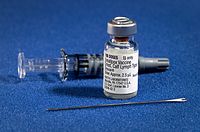
Photo from wikipedia
The recent years have been threatened by emerging and reemerging pathogens, like influenza viruses, Ebola virus, Zika virus, and, currently, SARS-CoV-2, which have rapidly spread globally causing large epidemics with… Click to show full abstract
The recent years have been threatened by emerging and reemerging pathogens, like influenza viruses, Ebola virus, Zika virus, and, currently, SARS-CoV-2, which have rapidly spread globally causing large epidemics with devastating health and economic consequences. These health emergencies dramatically resemble the dreadful epidemics occurring in the pre-antibiotics and pre-vaccine era, like plague and smallpox, whose elimination represented important conquests for humanity. New technologies are allowing the rapid development of effective prophylactic vaccines, the key weapons to defeat the virus, a goal that have been achieved with unprecedented efforts and speed for COVID-19 [1]. As to 10 December 2020, according toWorld Health Organization landscape documents, 52 COVID-19 candidate vaccines are in clinical evaluation (13 in phase 3 clinical trials) and 162 in preclinical evaluation. Results of phase 1 and 2 clinical trials have been published for inactivated whole virus vaccines, recombinant adenovirus vectored vaccines (rAd5-, rAd26-, and chimpanzee ChAdOx1-vectored vaccines), mRNA vaccines (mRNA1273 and BNT162b2), and recombinant SARS-CoV-2 spike protein nanoparticle vaccine, which showed the acceptable safety profile and high immunogenicity of all vaccines [1]. In addition, results from phase 3 clinical trials with mRNA vaccines show over 90% efficacy at preventing COVID-19 [2, 3]. However, these efforts are likely to be frustrated because of the pervasive misinformation about COVID-19 vaccines and the influence of the anti-vaccine movement in the media, which undermine vaccine confidence [4, 5]. Even this anti-vaccine conspiracy is not novel in human history. It represented a major obstacle in defeating smallpox, a viral disease that killed between 15% and 30% of infected individuals and was eradicated thanks to vaccination. The attitude and debate against the first immunization practices were well documented by a little-known anecdotal case from Padua, in the Venetian Republic in the 1700s: Abbot Pietro Ceoldo, who wrote a few lines in the margins of his 1788 printed liturgical calendar. These handwritten lines describe the variolation procedure, which was courageously performed by countess Arpalice Papafava to protect her 4-year-old son Alessandro. The child was engrafted with the purulent discharge from one of her healing servants; seven days after the inoculation, he developed fever and some pustules, but recovered rapidly and completely (Fig. 1) [6]. Countess Arpalice decision went against the attitude of general practitioners, of the medical and academic community, of the Church, and of mostly the common people who demonstrated violent opposition to smallpox inoculation [7]. European aristocracy and literate people were better informed of variolation validity, and indeed also, the Papafava family knew of the procedure by Lady Mary Wortley Montagu [8]. Lady Mary travelled a lot, and during one of her frequent visits to Venice, she resided in Padua for a few months probably as an acquaintance to the Papafava family who subsequently taught countess Arpalice how to perform the variolation. Indeed, only few books and scientific reports, occasional accounts from England, France, and Turkey, and military armies, along with revolutionary and anticlerical ideas, brought all around Europe the practice of variolation from Middle East countries, mainly Turkey. The energetic Lady Montagu also found fierce resistance, but eventually succeeded in the dissemination of her experience with the cure of the Crown family [8]; until in 1796, Edward Jenner realised the definitive solution, using cowpox material for smallpox vaccination. A similar story occurred for This article is part of the Topical Collection on Quality in Pathology
Journal Title: Virchows Archiv
Year Published: 2021
Link to full text (if available)
Share on Social Media: Sign Up to like & get
recommendations!